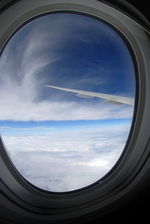Plane Talk: Got a question? Ask the Captain!
Do you have a question about airline safety, flight etiquette, jet lag, or air travel in general? Submit your question and look for answers in a future column.
 "I fly a lot and love to travel. In spite of this, I have never gotten over my fear of turbulence. I have what may be called "anticipatory anxiety". The minute I step on the plane I worry over the "anticipated" turbulence. I know in my mind that turbulence isn't dangerous, but I guess in the deep corners of my mind, I feel that the plane may go out of control, or fall, or ???? How can I get over this fear? I've tried therapy, biofeedback and relaxation techniques. They work to a certain extent." - Margo
"I fly a lot and love to travel. In spite of this, I have never gotten over my fear of turbulence. I have what may be called "anticipatory anxiety". The minute I step on the plane I worry over the "anticipated" turbulence. I know in my mind that turbulence isn't dangerous, but I guess in the deep corners of my mind, I feel that the plane may go out of control, or fall, or ???? How can I get over this fear? I've tried therapy, biofeedback and relaxation techniques. They work to a certain extent." - Margo
 Hi Margo,
Hi Margo,
I certainly understand your anxiety and you are definitely not the "Lone Ranger" out there. A medical doctor, I am not. Nor am I a doctor of any sorts, I am a pilot. What I share with you is knowledge from this perspective. I hope what I say is of some help. I can explain to you the "why" and "how" an aircraft flies, but here, I will briefly go over some flight conditions.......just for you.
Hummmmmm ................turbulence, the "rock and roll" of flying.
First let me say......
Aircraft are actually "airships" riding on and in rivers of air instead of water. They ( the airships...a.k.a. airplanes ) are designed and manufactured to a much higher standard than almost any other type of construction. This is so airplanes can bend by design and yet, stay strong. These are both good things.
For aircraft, every "nut and bolt" has a higher standard in material requirement. If it is to be used on or in and aircraft, it just has to be that way. This is so that when things go "bump" in the night, you can be assured everything will be J U S T fine.
Some proverbial turbulence...and as brief as possible.
Wake turbulence.........This will get your attention, but should not last long. It is caused by that aircraft in front of you. You can not see this bump in the road, but the controllers generally do a great job keeping enough "extra" space between some particular aircraft. For example, on take off after a "heavy"( an example would be a Boeing 747 or a Boeing 777, etc. ), the controller will give the next aircraft departing a two minute or a five mile separation. Yes, I just love little the team work here.
Now that pesky term of "hitting an air pocket". This is a really big misnomer. Hole in the air? Wooooooo !!! . Or is that Holy Air, Batman ?? I get the little crazies just thinking about this term. Holes and pockets in the air?? Air is everywhere out there. That term actually means you are just crossing different air current barriers. This experience can be a real "shocker" and usually seems worse than it is. But...but, it definitely pays to keep that ol' seat belt fastened while seated.
Now the Big Puffies in the sky.............they look sooooooo innocent....much like pillows of cotton balls.....or marsh mellows. yummmmm!!! yummmmmm!!!. Don't be fooled.
Holy Moly, that is just the opposite of what they can be. The pilot needs to give these puppies a wide berth. Especially the big boys with the flat anvil like tops.
Then there is the mountain wave effect.
When I see this term, I always hear that song by the late John Denver in my ear....Rocky Mountain High. Why? Because the air currents that follow the Earth, is forced "up and over" mountain ranges.... like the Rockies. Sometimes you can detect a "ripple" as you pass over them. It's the up and down and over the hill feeling you can get when traveling in a car.......at a higher rate of speed. The greater the altitude distance up over the range, the better the ride….. usually.
OK.......there are more natural "bumps in the night", but I was going to be brief.
Let me change the subject ...just a tad.
This is the good news part.
Margo, did you know that flight crews (pilots) practice how to detect.......and recover from various turbulence situations every time they have a flight simulator check. I will say some "technique" recoveries are "practiced more than others in their recurrent "sim check". Enough said here.
And......and....on the technical front, both the "ground" and "airborne" equipment just "keep on gettin' better." These innovations help in both the detection and recovery in so many forms of turbulence.
Now the "however" part.....which is the best news. This is very, very, important.
Pilots talk to each other. When they encounter some choppy air, they are required to "pass the word" to other pilots and to the air traffic control system as well. Margo, did you know sometimes, the controllers will initiate the inquiry with.........."how's your ride at 330".....that's flight level 330 or 33,000 feet above sea level. Everybody needs to be in the "safety of flight" loop. It is very normal to hear some pilot calling for "some chop" passing a certain fix. This gives all pilots a "heads up" and time to prepare for that possible "bump in the road."
So, what I am saying, Margo, is that "life is good". Flying is getting better, smoother, safer......and the pilots are talking to each other out there. Yes, these are good things !!
I hope this helps a bit.
Again, thanks for the question.
Now…………
Let's go fly !!!
Answering your questions in our NEW ASK THE CAPTAIN column is, Michael Wiggins, a retired airline pilot who has spent the better part of his life shuttling passengers around the globe. Do you have questions for YourLifeIsATrip's airline pilot? Submit your question and look for answers in a future column.

